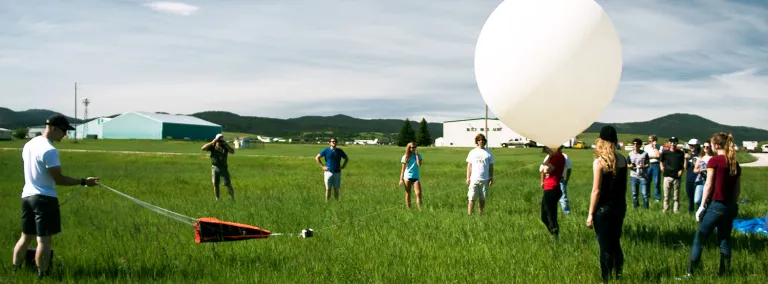Sanford Lab collaborates in the NASA Eclipse Ballooning Project
Preparations to launch a balloon for the total eclipse are underway.
In 1979, the United States experienced a rare event: a total eclipse of the sun that hit four states. On Aug. 21, skies will darken from Oregon to South Carolina as the moon passes between Earth and the sun. To better understand this phenomenon, NASA has teamed up with scientists, teachers and students across the country to launch high-altitude balloons from 30 locations during the eclipse.
And Peggy Norris, Sanford Lab’s deputy director of Education and Outreach, plans to be in the path of the eclipse with a group of students from South Dakota and Nebraska. Norris travels around the world to view eclipses—the one on August 21 will be her sixteenth.
This eclipse is special, though, she said. “I don’t have to travel around the world to see this one. It’s right in our own backyard!”
Norris is coordinating the team that will launch a Total Eclipse Balloon from Scottsbluff, Nebraska. The team includes high school and college students, educators and parents.
But before they can launch on Aug. 21, they need to design the equipment and carry out practice launches, one of which will take place on Neutrino Day. Spectators will be able to see the helium-filled balloon ascend to the sky from the launch site at Manuel Brothers Park in Lead at 9 a.m. Saturday, July 8.
The balloon is expected to reach 100,000 feet. Cameras will capture high-resolution photos and live video streaming, while other equipment collects important scientific data during the flight. That data the will benefit researchers wanting to learn more about eclipses.
The groups will collect and share the data and video obtained during the eclipse.
NASA will host a live feed of the astronomical event for four hours as the eclipse moves across the country. The cameras attached to the high-altitude balloons will provide a fascinating glimpse of near space and the effect of the moon’s mass blocking the rays of the sun. This will allow people from all over the world to witness the event as it occurs.
In western Nebraska alone, more than 3 million visitors are expected to view the eclipse. Sanford Lab’s Norris said 500 students from Pine Ridge will be in Scottsbluff to witness the eclipse and balloon launch.
Preparing for the launch
Gina Bestgen, a mechanical engineering major at the South Dakota School of Mines and Technology and the deputy project manager for the project, said, there are a lot of things to do before the balloon is fully ready for the eclipse. For example, they need to protect the ground station from the weather. “We’re also working on a stability system for our GoPro camera, which will, hopefully, be pointed straight at the eclipse.”
Studying the effects of the wind, pressure, and temperature on the balloon once it reaches the stratosphere will help them predict how these variables will affect the balloon during the eclipse launch.
During a recent practice launch, the team was joined by this year’s 2017 Davis-Bahcall Scholars. As they prepared to release the balloon, several team members exclaimed, “It’s so hard to let it go!” But they did let go.
The balloon expanded and contracted high above the clouds, then popped and the payload parachuted back down to the ground. The team scurried to track the payload’s signals then packed their gear into the vehicles that would take the recovery team to the landing site.
Wide open land is optimal for a landing site and the team coordinates with the FAA and landowners to be sure the balloon will not become a safety hazard or create problems.
“NASA science on the ranch!” said Mark Young, a volunteer mentor for the balloon launch team, explaining how some local ranchers have embraced being potential landing sites for the practice balloons.
For more information, visit NASA at: https://eclipse2017.nasa.gov/eclipse-ballooning-project)
